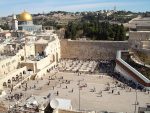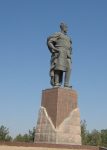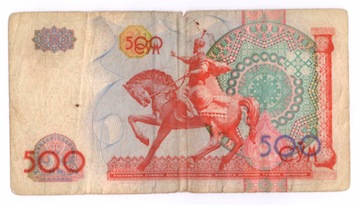It was a life-changing day for Sei Mang Khong Sai, a 35-year-old man from Sazal, India. Inside the mud and bamboo hut on stilts with him were community leaders, his family and guests. They chanted tribal prayers to the beat of a lap drummer.
In this village, hours away from any major city, they were preparing for the barhote, the bris. Sei Mang was about to enter the covenant. In an area of warfare, poverty and drug-running, he was seeking Judaism’s deeper connection to a peaceable life.
Before the ceremony was complete, however, he was to be given his Jewish name. The honor was spontaneously given to visiting stranger Bryan Schwartz, from Oakland, Calif. The first thing that came into Schwartz’s head was Menashe, and so Menashe it was.
A kippah was placed on Menashe’s head, the hut’s doors were thrown open and the assembled outside were informed of the new name, to cheers of “siman tov!” and “mazal tov!”
As the history is told, seven Jewish couples were shipwrecked off the Konkan coast in India, south of Bombay, some 2,000 years ago, the progenitors of today’s Bnei Israel of India’s Maharashtra province.
“It was a pretty astonishing moment for me that brought home both the commonality, the amount that we share even in the most diverse corners of the world, and also how different some Jewish lives are from the one that I have,” said Schwartz, a civil rights attorney.
Sei Mang’s story and many others – from Schwartz’s travels to 30 countries and more than 100 villages – are chronicled in Schwartz’s recent book, Scattered Among the Nations: Photographs and Stories of the World’s Most Isolated Jewish Communities, which he put together with Jay Saul and Sandy Carter.
Scattered Among the Nations is the culmination of a 15-year journey that began in 1999 when Schwartz was a law student and was planning a spring break trip to North Africa. He stumbled upon a listing for Jews in the index of his Lonely Planet guidebook, including historical descriptions of the island of Djerba in the Mediterranean off the coast of Tunisia. Jews there claim not only to have in their possession the oldest Torah, but a past extending directly to ancestors fleeing the destruction of the Second Temple. It is believed that some high priests – kohanim – found refuge on the island, bringing with them one of the gates of the Temple, which they later buried. Legend has it, a synagogue, which still stands today, was built overtop the burial site. Schwartz learned there were 15 synagogues on the island.
“I’m reading all of this and I’m just blown away that there is this place that is so fascinating, and a story that is so colorful and beautiful, and that I have never heard of it,” he told the Independent. “I decided there must be places like this all around the world that I could visit and, as a writer and photographer, capture some of it and share it with other Jewish people.”
Prior to embarking on this ambitious quest, he contacted some communities by fax and mail and connected with global Jewish outreach centre Kulanu, which has ties to Jews in far-off corners. He also researched the “lost” communities, reading Hillel Halkin’s book on the Bnei Menashe, Across the Sabbath River, and Tudor Parfitt’s The Lost Tribes of Israel and Journey to the Vanished City, about the Lemba tribe of southern Africa, who maintain Jewish practices and share kohanic DNA. He took special note of the 1999 documentary film by Simcha Jacobovici, Quest for the Lost Tribes of Israel.
“Some of these communities exist in places so geographically and culturally distant from other Jews that they must struggle daily to maintain the religion of their ancestors,” he said.
Scattered Among the Nations contains more than 500 color photographs. Over the course of two years, Schwartz’s articles and talks have gained attention globally in the media, learning institutions, houses of worship and Jewish museums.
“I wanted to show the full diversity of the Jewish world,” he said. In Sefwi Wiawso, Ghana, for example, Jews don’t know how they got there – perhaps an ancient Israelite exile or Ethiopian Jewish traders. But what’s certain is that the community of 200, who call themselves the House of Israel, is dedicated to living a Jewish life.
“They embrace Judaism with such love. They have this tiny Torah that somebody delivered to the community,” said Schwartz. “And then, to return home and to see in my synagogue the wall of Torahs in the ark … Torahs draped in silver and velvet, and realize how very fortunate we are to have the kind of resources that we have.”
An “extraordinary part of the journey,” said Schwartz, was showing up, not knowing a single soul, “and just by virtue of this Jewish faith that was shared, that I would be treated like a long lost cousin and brought in, and I could stay with a family for Shabbat or for a whole week or for several weeks, and nothing be asked of me at all, other than to join them.”
In fact, he said, even members of economically disadvantaged communities offered him the best room in the house in which to stay, three meals a day and touring.
In Ghana, for instance, he stayed in Joseph Arma’s house – one of the wealthier community members – where only one room had electricity. The home had an outhouse.
Arma’s nephew was staying with them, but Arma kept referring to him as his son. Confused, Schwartz asked for clarification. It was explained that the tradition is that people who have kinship with one another can be called son – and that its what this American visitor would soon be called, as well. “That’s how it is here in Africa,” he was told.
“This is how I was treated in a lot of communities, like I was the son of the community and as much a part of the family as anyone else,” he said.
Meanwhile, more than 100 people of the Shona Jewish community convene each Shabbat morning at their synagogue outside Rusape, Zimbabwe. It is there they sing original Afro-Jewish melodies, gospel-style, in Hebrew, Shona and English.
The Ebo Jews in Nigeria, on the other hand, consist of several thousand members.
In each locale, their practices are recognizably Jewish, though continued observance of said practices often requires outside assistance.
The Inca Jews in Peru, as they identify themselves, have struggled to maintain the traditions.
“They don’t have teachers, they don’t have clergy, they don’t have books and the resources to buy kosher foods that they want for holidays,” Schwartz said. They are by necessity vegetarian, he explained – not by choice, but due to the fact that kosher meat is unavailable.
This is one of the many reasons that it wasn’t enough for Schwartz to simply publish his book and hope that these communities would be able to continue practising Judaism despite their lack of resources. Instead, he has also launched Scattered Among the Nations, Inc., a nonprofit organization that is designed, among other things, to assist isolated Jewish communities in gaining the recognition and resources to meet their needs. The organization, for example, has helped the Inca Jews buy kosher meat for Pesach and the High Holidays.
A number of communities – including the Inca Jews – don’t have kosher Torahs and, at one point, the community in northeastern India had to use a toy Torah, the kind bar mitzvah kids are given, said Schwartz. After reading an article about this situation, septuagenarian Chicagoan Sam Pfeffer stepped up to the plate, offering to purchase a Torah. But it’s not as though the scroll could be mailed or couriered. To avoid the reams of red tape, the only route was to deliver it personally. And so it was that this community, for the first time in perhaps several hundred years, leined from a fresh, new Torah.
“Nothing in the world could have meant more to them,” said Schwartz. “In northeastern India, you know, there is just not enough hope. Economically there, life is a struggle and to get to Shabbat really is a salvation every week.”
Whole communities – including the Bnei Menashe and Inca Jews – have expressed a strong desire to make aliyah in order to live fuller Jewish lives. But they haven’t necessarily been met with the warmest of receptions.
“It felt to me like an injustice that this [Inca] community has been actively and deliberately practising Judaism for decades, and really struggle to gain attention from the outside Jewish world. They’re fighting to get the attention of the [rabbinical authorities], to practise and make aliyah,” said Schwartz. “That was a fight that felt like … social justice that I engage in my law practice as well. Some of what I have seen … has felt like discrimination to me, and I think it’s something we need to confront and address.”
After some of the first members of the Inca community made aliyah, an Israeli newspaper wrote editorials suggesting that these Peruvians were just the pawns of an Orthodox establishment trying to use them in the war against the Palestinians, recalled Schwartz. “Which, to me, is an incredibly … bigoted way to look at a group of people, to suggest they were sort of evil-minded, or did not have their own free will to exercise their own passionate conserving of Judaism.
“In fact, nothing could be farther from the truth. The community actually struggled for a long time to gain any recognition for their own very devoted Jewish practice … to the point where they were photocopying pages of the Chumash and sticking it to parchment, to make it a ‘Torah.’ It’s hard for most of us to imagine.”
The Bnei Menashe of Myanmar (Burma) and India only recently gained official recognition as a “lost tribe” from religious authorities.
“It was so fundamental to their identity that they were part of a lost tribe,” said Schwartz, puzzled at the inconsistencies. Why, he wondered, when so many Soviet Jews “were welcomed with open arms in Israel, despite so few devoted in their Jewish practice,” do Bnei Menashe, in contrast, “not have the same reception? I think that’s something that we need to continue to confront as a community.”
It seems that clashes with so-called mainstream Jewish life have become the rule, rather than the exception. In the 1980s and 1990s, for example, Jews in Mexico and Portugal emerged from centuries of isolation, “coming out” for the first time since the Spanish Inquisition, as Schwartz explained. “Now that they no longer are forced to hide their Jewish practice, that they’re not as isolated as they once were, while it is a blessing, it also causes challenges.”
Reconnecting to the Jewish world meant newfound (to them) rabbinical insight that often conflicted with their own traditions, he explained. Portuguese prayers would make way for Hebrew prayers; kashrut meant a whole other list of laws and strictures. The Jewish community in Portugal had been, for hundreds of years, developing secret (to us) Jewish practices, including a Shavuot they referred to as Ascension Wednesday, a gathering in the field to celebrate.
“It was a struggle in the community as to what extent to embrace modern Jewish practice, or to keep going with their … practices that they’ve had for centuries,” said Schwartz. “Suddenly, you’ve come face to face with the entire Jewish world and realized that the way you’re practising is not entirely consistent with the way the other communities are practising and you have to make decisions.”
Schwartz couldn’t help but be affected by the faith of these communities, in light of what would often be harsh circumstances.
“In visiting these communities,” he said, “I realized the struggle that some people have to get to survive every week, and how meaningful it is to really live the whole week, to arrive at Shabbat. It is just inspiring. It made me realize the gift that it is to be Jewish, and it makes me want to pray every day, and be grateful every day, in a way that I certainly wasn’t before.”
Dave Gordon is a Toronto-based freelance writer whose work has appeared in more than a hundred publications around the world. He is the managing editor of landmarkreport.com.







